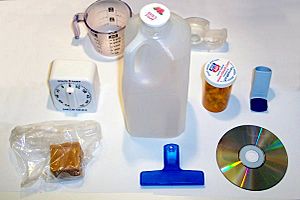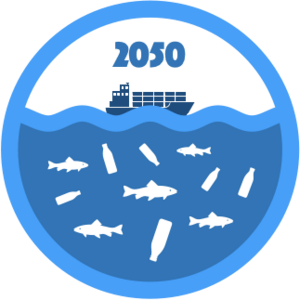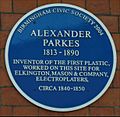Plastic facts for kids
A plastic is a special material that can be shaped into many different things. Think about all the plastic items around you – toys, bottles, and even parts of your phone! Some plastics can only be shaped when they are first made, then they become hard. Others can be heated up and reshaped again and again.
Most plastics are made by people, not found in nature. They usually come from petroleum (oil) or natural gas. Making plastic is often a complex process. Most materials we call plastic are actually polymers. Imagine polymers as very long chains of tiny atoms linked together.
People have been experimenting with plastic-like materials for a long time. An English inventor named Alexander Parkes created one of the first forms of plastic in 1855. It was strong but flexible and clear, and he called it "Parkesine."
Plastic is very useful, but it can also cause problems. It fills up landfills (places where trash is buried), and if you burn it, it can release harmful fumes. That's why recycling plastic is so important!
Contents
How Plastic is Made
Most plastics are made from petroleum, which is a type of oil. Engineers take this oil and put it through a heating process. This process creates special chemicals like ethylene and propylene. These chemicals are the basic building blocks for many plastics. They are then combined with other chemicals to create a polymer, which is the long chain of atoms that makes up plastic.
Common Types of Plastic and What They're Used For
There are many different kinds of plastic, each with its own special uses:
- Polyamide (also known as nylon): Used for things like women's stockings.
- Polycarbonate: Found in strong materials like bulletproof glass, compact discs, and DVDs.
- Polyethylene: Often used to make plastic tubes.
- Polyethylene terephtalate (called PET): Used for bottles. When it's used for clothes or other fabrics, it's called polyester.
- Polypropylene: A versatile plastic used in many products.
- Polystyrene: Used for things like foam cups and egg cartons.
- Polyurethane: Found in foams, like those in furniture or sponges.
- Polyvinyl chloride (called PVC): Used for covering electric wires, pipes, and road signs.
Plastic and Our Environment
Most plastics are very strong and break down very slowly. This is because their chemical structure makes them resistant to many natural ways of breaking down. Experts estimate that billions of tons of plastic waste have been thrown away since the 1950s. A lot of this plastic can stay in the environment for hundreds of years or even longer.
Sadly, a lot of plastic ends up in our oceans. Some reports show that certain countries dump more plastic into the sea than all other countries combined. Large rivers also carry a huge amount of plastic waste into the ocean.
Tiny pieces of plastic, called microplastics, are now found more and more in the food chain. They have been seen in seabirds since the 1960s and are now found in many animals. Scientists are still trying to understand the long-term effects of plastic in the food chain. It's estimated that plastic makes up a large part of the trash found in marine areas.
Plastic and Climate Change
Plastic can also affect climate change. In 2019, a report called "Plastic and Climate" showed that plastic production and disposal release a lot of Greenhouse gases, like Carbon dioxide (CO2), into the air. If we continue at the current rate, plastic could contribute a huge amount of greenhouse gas emissions by 2050.
When plastic is burned, it releases carbon into the atmosphere. If it's put in a landfill, it can store carbon, but some biodegradable plastics can release methane, another greenhouse gas. On the other hand, plastic is lighter than glass or metal. This means that transporting plastic items, like drinks in plastic bottles, uses less energy, which can help reduce carbon emissions from transportation.
How Long Does Plastic Last?
Plastic makes up about 10% of all discarded waste. Different types of plastic break down at different rates. In salty ocean environments, plastic can break down even slower because of the cool water. However, some studies show that plastics in the ocean might break down faster than once thought due to sun and rain. This can release harmful chemicals like bisphenol A.
Here are some estimates of how long different plastic items take to break down:
- A foam plastic cup: 50 years
- A plastic beverage holder: 400 years
- A disposable nappy: 450 years
- Fishing line: 600 years
- Styrofoam cups: thousands of years
Some scientists believe that if we don't act, the ecosystems in our seas and oceans could collapse in the next 25 years. This could even affect life on Earth as we know it. To prevent this, experts suggest banning single-use plastics, planting more trees, and making sure all industries stop releasing toxic waste by 2030.
Microbes That Eat Plastic
Believe it or not, some tiny living things, called microbes, can actually break down plastics! Scientists have found different types of bacteria and fungi that can "eat" certain plastics.
- In 1975, Japanese scientists found a type of bacteria called Flavobacterium that could digest some byproducts of nylon.
- Some soil fungi, like two species of the Ecuadorian fungus Pestalotiopsis, can consume polyurethane.
- Certain bacteria can break down styrene, which is used in polystyrene.
- Microbes found in soil can degrade polypropylene.
- Several fungi, like Aspergillus fumigatus, can break down PVC.
- Bacteria like Acinetobacter and Pseudomonas fluorescens can partially degrade polyethylene.
- Even in the Sargasso Sea, bacteria have been found that consume various types of plastic.
These discoveries are exciting because they might help us find new ways to deal with plastic waste in the future.
Recycling Plastic
Recycling is a key way to deal with plastic waste. Thermoplastics can be melted down and used again, while thermoset plastics can be ground up and used as a filler material. However, the quality of the plastic can go down a bit each time it's recycled.
One of the biggest challenges in recycling plastic is sorting it. It's hard to sort plastic waste automatically, so workers often have to do it by hand. They usually look for a special recycling code on the plastic to identify its type. For example, the caps on plastic bottles are often made from a different type of plastic than the bottle itself, which makes sorting more complicated.
While simple containers are easier to sort, complex items like cell phones can have many small parts made from different plastics. It can be too much work to separate them, so these items often get thrown away. However, new technologies are being developed to make plastic recycling more efficient.
Sometimes, recycling certain plastics, like polystyrene, isn't very profitable. When plastics aren't recycled, they usually end up in landfills, are burned, or are used to create electricity at special waste-to-energy plants.
One successful recycling method is called Vinyloop. This process separates PVC plastic from other materials using a special liquid. This allows composite PVC waste, which would normally be burned or landfilled, to be recycled. This method was even used after the 2012 Olympic Games in London to recycle parts of temporary buildings.
To help with recycling, the plastic industry created a system in 1988 to mark plastic bottles with a special triangle of three "chasing arrows" and a number inside. This symbol helps people know what type of plastic an item is made from, making it easier to recycle.
Images for kids
-
Plastic compounding scheme for a thermosoftening material
-
Kinder Joy shell made of polypropylene
-
iPhone 5c, a smartphone with a polycarbonate unibody shell
-
10m deep Monterey Bay Aquarium tank has acrylic windows up to 33 cm thick to withstand the water pressure
See also
 In Spanish: Plástico para niños
In Spanish: Plástico para niños



























